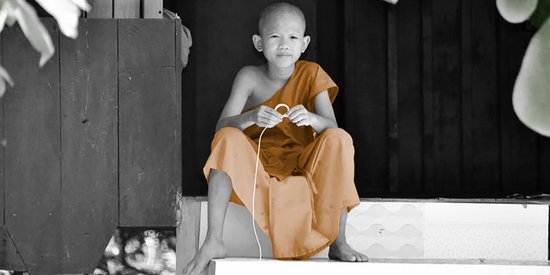It was at the beginning of the 20th century that Carl Gustav Jung, a Swiss psychologist, was the first to use the therapeutic power of the mandala to help his patients find balance, consistency and inner peace.
Using the mandalas, you can access the subtle realms, you will enter an intimate place which is outside of time and space: the sacred circle. Because mandala means "sacred circle" in Sanskrit. It represents a universal symbol. The mandala is a more or less symmetrical creation elaborated around a central point. Each mandala represents the idea of convergence and balance with respect to a real or a fictitious center.
The practice and creation of the mandala come from a spiritual technique of Indo-Tibetan origin (Hindu and Tibetan religious traditions). For them, it is a sacred ritual. Mandalas are built according to very precise and strict rules according to these traditions. Mandalas allow humans to relate to the cosmos. They are symbols of unity, totality and perfection.
The origin of the mandalas remains undetermined. The creation of a universe, that is to say the big bang : is it not in itself the starting point of an immense cosmic mandala? Thus, it is the expression of the creative force of the universe, from the infinitely large to the infinitely small, from the spiral of the galaxies to the planetary orbits of our solar system; from the celestial spheres of the sun and the moon to the circular and spiral movements found in crystals, snowflakes, flowers or atoms.
The zodiac and our solar system, too, could be compared to a large mandala with the sun occupying the central point.
Mandalas are not artistic and spiritual expressions exclusive to oriental traditions, because they are found in all cultures, in all civilizations and in every era. Very ancient places of worship, such as “Stonehenge”, which dates back to the Neolithic era, were arranged according to the eternal principles of the mandala. In the West, the stained glass windows of some churches and those of large cathedrals were designed according to the geometric principle of the mandalas. In the Americas, we found circular constructions serving as astronomical calendars among the Incas of Peru, and dating from the 15th century.
These magnificent luminous rosettes are, for us Westerners, the most wonderful example. In the East, its forms are even more numerous, but it is above all Tibetan Buddhism that has perpetuated the tradition to this day.
Certainly, the main objective of mandalas is to bring us to reflection, meditation and the quest for our divine center, but it can also be used for other purposes, including therapeutic ones, like chromotherapy or music therapy ...
Symbolic elements:
The wheel: Symbol of the dynamic of the human development, of transformation. Symbol of perfection. Its 8 rays correspond both to the 8 paths leading to awakening and to the 8 directions of the compass rose. Set in motion by the Buddha's first sermon, the wheel of the law frees human beings from the ordeal of suffering
The tree: Symbol of spiritual enlightenment. When inverted, the tree represents the celestial origin of Man. Man rediscovers himself and discovers his inner life.
The lotus: Symbol of inspiration for purity. The lotus position symbolizes the attainment of enlightenment. All human beings, whoever they are, thus access enlightenment.
Water and light: Light symbolizes the path to be traveled; it sheds light onto our vision of the world. Water symbolizes the expectation of healing and the satisfaction of wishes; it is the support of meditation.
The lion: Symbol of power. Repressed energies are then released and expressed in a way that they can be controlled.
The nagas: Symbol of rebirth.
Offerings: Symbol of devotion (most often these are incense, candles, flowers).
Rosaries and mills: Symbol of devotion (correspond to malas and prayer wheels).
Symbolic forms:
The circle: Represents the sky and the weather. It corresponds to a fig of protection. Combined with the square, it symbolizes change.
The square: Symbolizes stability.
The triangle: It suggests union and harmony. It can be a symbol of perfection.
The star: It is the source of light, the one that guides Man.
Symbolic colors:
Red: Symbolizes joy, health, triumph; it is a symbol of life. A very bright red represents anger.
Orange: Symbolizes the feeling of well-being and good humor; which concerns the pleasures of life (of the table, the body and of strong sensations).
Yellow: Symbolizes spiritual light; it can also lead to selfishness and pride.
Green: Symbol of regeneration; it has a calming, toning, refreshing effect.
Blue: Symbol of immortality; it calms and soothes.
Purple: Symbol of spirituality.
Black: Symbol of fertility
White: Symbolizes purity, unity.
Gold: It characterizes absolute perfection. Symbol of knowledge.
The practice of the mandala allows you a great opportunity for relaxation while developing your creativity. It allows you to focus, to illuminate your personal and / or professional journey or, quite simply, to de-stress.
You can then adorn your home with your creations and contemplate them! Each mandala will be a support for your visual meditation!









